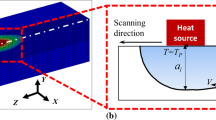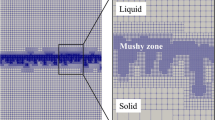Abstract
During the preparation of the ingot with liquid core in the early stage, the finite element models of the solidification and the ultra-high temperature demoulding were established in DEFORM-3D. The thermophysical properties of ASSAB 718 with the variations of C, Mn, and Cr were calculated in JMatPro®. The material database was imported into DEFORM-3D. Through the analysis of finite element simulation results, we obtained the influence of three main elements C, Mn, and Cr contents on the size of the solid-phase region, the liquid-phase region, and the solid-liquid two-phase region in the ingot. We optimized the composition of the material to get a wide solid-liquid phase range. The medium/high carbon, the medium manganese, and the high chromium contents were beneficial to form the liquid core. Based on the method of the solidification time, the algorithm was programmed by the python language. We analyzed the influence of the three elements C, Mn, and Cr on the concentration distribution based on the temperature field data, which were obtained by DEFORM-2D after the solidification and the ultra-high temperature demoulding. According to the simulation results, we found the region prone to negative segregation.












Similar content being viewed by others
Availability of data and materials
The data used to support the findings of this study are included within the article.
References
Wang KK (2015) The current situation and thinking of material processing industry in Gansu Province. Love Longyuan-the 15th batch of achievements of Doctor Service Group on probation: 221.
Wang KK, Fu W (2017) Hu ZQ (2017) A high uniformity short process forming method for large metal components. China:ZL 1:1262274.8
Wu YQ, Wang KK, Ruan SR (2021) A new forging technology of 19 tons flat ingot with semi-solid liquid core. The International Journal of Advanced Manufacturing Technology 112(9-10):2899–2999. https://doi.org/10.1007/s00170-020-06524-y
Dong J (2005). Numerical simulation of temperature and thermal stress field in steel ingot solidification process and application. **’an University of Architecture and Technology, **’an.
Dong J, Yuan SQ, Deng LT, Liu XY (2007) Numerical simulation of temperature field in steel ingot solidification process. Foundry Technology 28:268–270
Zhao XZ, Fan YB, **a QX, Lu MK, Du YL (2013) Research and optimization of heating process before forging for 5CrNiMo hot working die steel. Hot Working Technology 42:110–113
Zong WQ, Wu Z, Shan HX, **a QX (2012) Distributions of temperature and stress during ingot heating when charging at high temperature. Hot Working Technology 41:4–7
Scientific Forming Technologies Corporation. DEFORM 3DTM Version 6.0 User’s Manual, Part 1: 10-16.
Martins PJ, Neto D, Alves J, Oliveira M, Menezes L (2016) Numerical modeling of the thermal contact in metal forming processes. The International Journal of Advanced Manufacturing Technology 87(5):1797–1811. https://doi.org/10.1007/s00170-016-8571-y
Cebo A (2010) The effect of the error of thermal conductivity, specific heat and density determination on the inverse calculation of the heat transfer coefficient. Archives of metallurgy and materials 55(2):429–434
Tlhabadira I, Daniyan I, Machaka R, Machio C, Masu L, VanStaden L (2019) Modelling and optimization of surface roughness during AISI P20 milling process using Taguchi method. The International Journal of Advanced Manufacturing Technology 102(9):3707–3718. https://doi.org/10.1007/s00170-019-03452-4
Liu HH, Fu PX, Liu HW, Sun C, Sun MY, Li DZ (2018) A novel large cross-section quenching and tempering mold steel matching excellent strength–hardness–toughness properties Materials science & engineering. A, Structural materials: properties, microstructure and processing 737:274–285. https://doi.org/10.1016/j.msea.2018.09.046
Olovsjö S, Hammersberg P, Avdovic P, Ståhl J, Nyborg L (2012) Methodology for evaluating effects of material characteristics on machinability—theory and statistics-based modelling applied on Alloy 718. The International Journal of Advanced Manufacturing Technology 59(1):55–66. https://doi.org/10.1007/s00170-011-3503-3
Saunders N, Guo U, Li X, Miodownik A, Schillé J (2003) Using JMatPro to model materials properties and behavior. JOM 55:60–65. https://doi.org/10.1007/s11837-003-0013-2
Schillé JP, Guo ZL, Saunders N, Miodownik AP (2011) Modeling phase transformations and material properties critical to processing simulation of steels. Materials and Manufacturing Processes 26:137–143. https://doi.org/10.1080/10426910903153059
Romashkin A, Tolstykh D, Dub V, Malginov A, Ivanov I (2014) Study of the effect of ingot geometry on its solidification features based on cold simulation. Part II*Metallurgist 58(3):179–183. https://doi.org/10.1007/s11015-014-9888-0
Kermanpur A, Eskandari M, Purmohamad H, Soltani MA, Shateri R (2010) Influence of mould design on the solidification of heavy forging ingots of low alloy steels by numerical simulation. Materials in engineering 31(3):1096–1104. https://doi.org/10.1016/j.matdes.2009.09.045
Ren HJ, Liang XP (2012) Prediction of macro segregation to heavy ingots by advanced solidification time method. Heavy Casting and Forging 1:1–5
Ren HJ (2011) The algorithm research to the macro segregation prediction of the heavy ingot solidification process. Chongqing University, Chongqing
Chen KX, Shen HF (2019) Modeling of macrosegregation benchmarks using a stabilized finite element algorithm based on a semi-implicit pressure correction scheme. International journal of numerical methods for heat & fluid flow 30(2):18–933. https://doi.org/10.1108/HFF-10-2018-0544
**e MY, Shen HF (2020) Multiphase model for the prediction of shrinkage cavity, inclusion and macrosegregation in a 36-Ton steel ingot. Frontiers in Materials. https://doi.org/10.3389/fmats.2020.577290
Lesoult G (2005) Macrosegregation in steel strands and ingots: characterisation, formation and consequences. Materials science & engineering. A, Structural materials 413:19–29. https://doi.org/10.1016/j.msea.2005.08.203
Acknowledgements
The authors would like to sincerely thank the National Key Research and Development Program of China (2017YFB0701803)for the financial support.
Funding
This work was financially supported by the National Key Research and Development Program of China (2017YFB0701803).
Author information
Authors and Affiliations
Contributions
Kai-kun Wang contributed to the conception of the study.
Yong-qiang Wu performed the experiment, contributed significantly to analysis and manuscript preparation, performed the data analyses, and wrote the manuscript.
Corresponding author
Ethics declarations
Ethics approval and consent to participate
Not applicable
Consent for publication
That the work described has not been published before (except in the form of an abstract or as part of a published lecture, review, or thesis).
That it is not under consideration for publication elsewhere;
That its publication has been approved by all co-authors, if any;
That its publication has been approved (tacitly or explicitly) by the responsible authorities at the institution where the work is carried out.
Competing interests
The authors declare no competing interests.
Additional information
Publisher’s note
Springer Nature remains neutral with regard to jurisdictional claims in published maps and institutional affiliations.
Rights and permissions
About this article
Cite this article
Wu, Y., Sun, Z. & Wang, K. The simulation of the preparation of the ingot with liquid core. Int J Adv Manuf Technol 116, 931–940 (2021). https://doi.org/10.1007/s00170-021-07538-w
Received:
Accepted:
Published:
Issue Date:
DOI: https://doi.org/10.1007/s00170-021-07538-w




